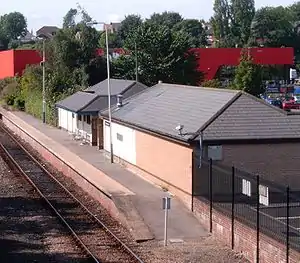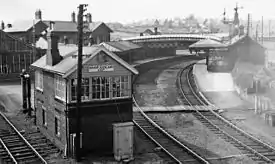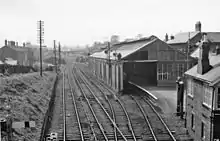Bishop Auckland railway station
Bishop Auckland railway station serves the town of Bishop Auckland in County Durham, England. The station is the western terminus of the Tees Valley Line (also referred to as the Bishop Line West of Darlington) 12 miles (19 km) north of Darlington.
 | |
| Location | Bishop Auckland, County Durham England |
| Coordinates | 54.6573°N 1.6778°W |
| Grid reference | NZ208291 |
| Managed by | Northern Trains |
| Platforms | 1 |
| Other information | |
| Station code | BIA |
| Classification | DfT category F1 |
| History | |
| Original company | Bishop Auckland and Weardale Railway |
| Pre-grouping | North Eastern Railway |
| Post-grouping | London and North Eastern Railway |
| Key dates | |
| 8 November 1843 | Station opened |
| Passengers | |
| 2015/16 | |
| 2016/17 | |
| 2017/18 | |
| 2018/19 | |
| 2019/20 | |
| Notes | |
Passenger statistics from the Office of Rail and Road | |


When it is operating, a connection can be made with the Weardale Heritage Railway at the nearby Bishop Auckland West railway station for trains towards Stanhope.[1]
History
Bishop Auckland gained its first rail link in 1842,[2] when the Stockton and Darlington Railway (S&DR) backed Bishop Auckland and Weardale Railway (BA&WR) gained the powers via an Act of Parliament to build a railway line from the S&DR's station at Shildon via Bishop Auckland and Witton-le-Wear into Crook, County Durham.[3]
The company initially built a temporary terminus at South Church, which opened on 19 April 1842. A road coach service then extended the service into Bishop Auckland, and a secondary road coach service also ran to Rainton Meadows. After completion of the Shildon tunnel, the BA&WR erected a permanent station on the current site, which opened to freight on 8 November 1843, and passengers on 30 January 1843.[3] All operations were sub-leased as agreed to the S&DR.[3]
In 1844, after the West Durham Railway extended from a junction with the Clarence Railway at Byers Green to Crook, the S&DR extended the BA&WR from Bishop Auckland along the river valley to Witton-le-Wear, and then into Crook. In 1845, the S&DR came to an agreement with the Derwent Iron Company to sub-lease the southern section of the former Stanhope and Tyne Railway. It extended the line from Crook to Waskerley and then to Blackhill, and it was opened as the Weardale Extension Railway (WXR).[3][4]
In July 1845 Parliament passed the Wear Valley Act, which allowed the extension of the BA&WR from a junction at Witton-le-Wear to Frosterley, and a small branch line across the river to Bishopley. With all works again undertaken by the S&DR, this line opened on 3 August 1847. After these works had been completed, the BA&WR amalgamated with the WXR. All service were operated by the S&DR, which officially took over the new company in January 1857.[3][4]
On 1 April 1857, the North Eastern Railway (NER) started a service from Durham to Bishop Auckland at a new terminus in Tenter Street. However, the S&DR and NER quickly came to the agreement of development of a joint station in the town, and so rebuilt the existing former BA&WR station, with NER trains using it from December 1857.[3][4]
In 1862, an Act of Parliament was passed allowing the S&DR backed Frosterley and Stanhope Railway to extend the line to Stanhope, thus allowing trains to transport limestone from the Newlandside Estate on the south side of the town. This brought about the extension of the South Durham and Lancashire Union Railway from Barnard Castle into Bishop Auckland in 1862, and with the final addition of traffic from an extension of the Clarence Railway at Byers Green, eventually resulted in the NER rebuilding the station again in December 1867.[3][4]
The final extension of the Weardale Railway to Wearhead opened on 21 October 1895, with the NER having resited the station at Stanhope to provide a more suitable gradient for the heavy limestone trains. Between Eastgate and Westgate at Cambo Keels, sidings were established to serve the Weardale Iron Company's Heights limestone quarry, which is still in operation today. This final extension of the Weardale Railway bought about the final and largest layout of Bishop Auckland railway station, which was now rebuilt in triangular form with four platforms in 1905.[3][4] Only three of these were normally used for passenger trains, with platform 1 handing trains towards Crook & Wearhead and platforms 2 & 3 dealing with services on the Barnard Castle, Ferryhill & Durham lines. Platform 4 (on the chord linking the Durham & Crook lines) was mostly used for parcels & newspaper traffic and for racing pigeon specials.
As elsewhere the UK, rail traffic in the area declined after World War II, with the Wearhead branch the first to lose its passenger trains in 1953. The principal closures came in the 1960s mainly as a result of the Beeching Axe, with services to: Barnard Castle via West Auckland ending in June 1962; Durham in May 1964;[5] and Crook in March 1965. This left only the former original S&DR line to Darlington line in operation, along with the freight-only branch traffic to Eastgate.[3][4]
The station remained more or less intact (although increasingly forlorn and run-down) for more than 20 years thereafter, though by the early 1980s only the former platform 3 was in use[4] (along with the former Bishop Auckland East signal box). It was eventually replaced by the current structure on 6 June 1986. This stands on the site of the former Crook branch platform, on a siding off the now single 'main' line which continues on towards Stanhope & Eastgate. The signal box was abolished at the same time, with neighbouring Shildon box assuming control of the much-simplified layout.
The remaining station buildings were then demolished and the site sold off for retail redevelopment. The former goods yard is now a supermarket with carpark, and the Durham platform is now the site of a cycling and motoring store and a bank.[4]
The station is currently operated by Northern, which provides National Rail passenger services. In 2012, Bishop Trains adopted the station from Northern Rail (the operator at the time), providing a National Rail Ticket Office and staff for the station. Bishop Trains have further developed the Ticket Office and now provide a booking service for coach trips and holidays, and more recently, rail charters. It is staffed six days per week throughout the year (Monday to Saturday 06:50-16:15). At all other times, tickets must be purchased in advance or on the train. Service running information is offered by timetable posters and Bishop Trains staff (when open). Step-free access is available from the main entrance to the ticket office and platform.[6]
In 2014, the station was revamped. In the former toilet block, a glass front waiting room was constructed, alongside a new toilet and office. Digital CIS displays have also been installed, as part of a scheme to provide these at all stations in the area (bar those at Teesside Airport and British Steel Redcar, which both have only a limited timetable).[7]
Station masters
- William Crawford 1843 - 1886[8]
- William Boyne ???? - 1895
- Matthew William Seymour 1895 - 1907[9] (afterwards station master at Darlington)
- Robert Cocks 1908 - 1920[10] (formerly station master at Monkwearouth)
- J.C. Pigg 1920 - 1921 (afterwards station master at Durham)
- J.R. Winter 1922[11] - ????
- A. Howe 1934 - ????
Services
Trains depart southbound to Darlington, Middlesbrough and Saltburn every hour through the day Monday to Saturday (with an additional p.m peak service). This is an improvement from the two-hourly off-peak frequency formerly in place prior to the December 2017 timetable change. The Sunday service is also now hourly until 20:00 since the timetable change in May 2018.[12]
Bishop Auckland West
The Weardale Railway has built a separate platform, called Bishop Auckland West, about 110 yards (100 m) west of the National Rail station, from which regular passenger services to Stanhope initially operated from May 2010 until the end of 2012.[13]
Since 2014, the Weardale Railway Trust has operated passenger trains on selected weekdays and weekends for mostly tourist traffic using a class 122 "Bubble Car". Initially, this only ran between Wolsingham and Stanhope but, on 27 March 2016, this service was extended to Witton-le-Wear[14] and, after works were carried out by the Weardale Railway Trust to lift a short section of track at Broken Banks (approximately 1/2 mile west of Bishop Auckland station) to enable the embankment to be repaired (subsidence had made the line unusable for passenger traffic for a number of years prior to the works being carried out),[15] since July 2018, two of the three daily return services between Stanhope and Witton-le-Wear have been extended to Bishop Auckland West station.[1]
References
- Body, G. (1988). PSL Field Guides - Railways of the Eastern Region Volume 2. Wellingborough: Patrick Stephens Ltd. ISBN 1-85260-072-1.
- Butt, R.V.J. (1995). The Directory of Railway Stations. Yeovil: Patrick Stephens Ltd. ISBN 1-85260-508-1. R508.
Notes
- "Weardale Railway - Timetables". The Weardale Railway Trust. Retrieved 3 July 2018.
- Body 1988, p. 43
- Butt 1995, p. 35
- "Bishop Auckland". Disused Stations. 2 March 2012.
- "Disused Stations: Bishop Auckland Station". www.disused-stations.org.uk.
- Bishop Auckland station facilities National Rail Enquiries; Retrieved 16 February 2017
- "Report of meeting with Steve Payne, Tees Valley Unlimited" North East Coastliners news article 29 June 2015; Retrieved 17 February 2017
- "Death of and old Auckland resident". Daily Gazette for Middlesbrough. England. 10 December 1886. Retrieved 28 February 2020 – via British Newspaper Archive.
- "N.E.R. Appointments". Newcastle Evening Chronicle. England. 14 December 1907. Retrieved 28 February 2020 – via British Newspaper Archive.
- "Blyth man retiring". Blyth News. England. 28 October 1920. Retrieved 28 February 2020 – via British Newspaper Archive.
- "N.E.R. Appointments". Newcastle Daily Chronicle. England. 3 May 1922. Retrieved 28 February 2020 – via British Newspaper Archive.
- Table 44 National Rail timetable, May 2018
- "Weardale Railway News 2010". Archived from the original on 23 July 2010. Retrieved 4 April 2010.
- Russell, Helen (27 March 2016). "Trains stop in County Durham village for first time in 50 years | The Northern Echo". The Northern Echo. Retrieved 25 March 2018.
- Conner-Hill, Rachel (9 April 2018). "Weardale Railway to extend service to Bishop Auckland | The Northern Echo". The Northern Echo. Retrieved 11 April 2018.
Further reading
- Whishaw, Francis (1842). The Railways of Great Britain and Ireland Practically Described and Illustrated (2nd ed.). London: John Weale. pp. 32–34. OCLC 833076248.
External links
| Preceding station | Following station | |||
|---|---|---|---|---|
| Northern Trains | Terminus | |||
| Terminus | Weardale Railway | Witton-le-Wear | ||
| Historical railways | ||||
| South Church Line open, station closed |
Stockton and Darlington Railway Bishop Auckland & Weardale Railway |
Etherley & Witton Park Line open, station closed | ||
| Disused railways | ||||
| West Auckland Line and station closed |
North Eastern Railway South Durham and Lancashire Union Railway |
Terminus | ||
| Coundon Line and station closed |
North Eastern Railway Clarence Railway (Byers Green Branch) |
Terminus | ||
| Terminus | North Eastern Railway Durham to Bishop Auckland Line |
Hunwick Line and station closed | ||
